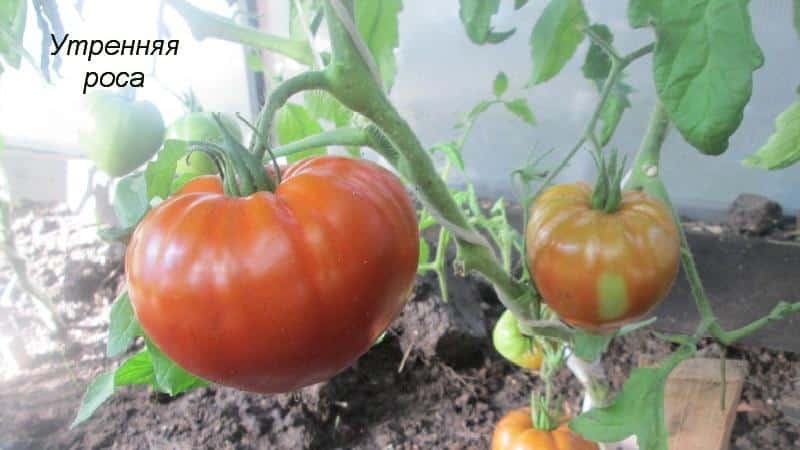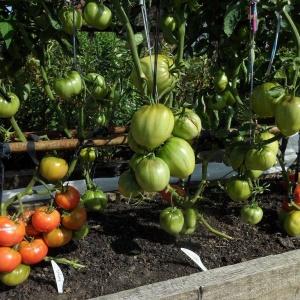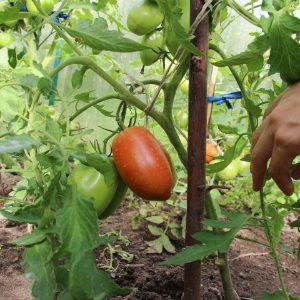A universal early ripening variety of tomatoes - the “Morning Dew” tomato
Who doesn’t want to grow tasty, meaty, and easy-care tomatoes on their property? And even reap a rich harvest in the shortest possible time! Meet the universal early ripening tomato variety – the Morning Dew tomato.
In this article you will find not only a description of the Morning Dew tomato variety, but also photos, reviews and specific recommendations for growing it.
Description
The Morning Dew tomato is a versatile tomato variety. This means that it can be grown in any region of our country. It grows equally well both in open ground and in greenhouses.
The Morning Dew variety is recognized as one of the best in terms of early ripening - already 3-3.5 months after planting the seeds, a rich harvest is obtained.
Tomato fruits are heart-shaped, fleshy, large and heavy (300-350 g), and have an excellent taste. A distinctive feature of the variety is its large fruits when they ripen early.

The plant is indeterminate, that is, tall. Therefore, when growing, its top must be pinched for better growth and a higher yield.
Productivity is high, up to five fruits on one cluster. One bush produces up to 3 kg of tomatoes. What is especially appreciated is that when the outside temperature changes, the bushes do not reduce their fertility.
Ripe fruits are not afraid of transportation over long distances and are stored in the cellar for more than 1 month. An obvious advantage is resistance to fruit cracking, which is observed in many similar varieties.
How to grow
Let's take a closer look at the features and nuances of growing Morning Dew tomatoes.
Planting seeds
When purchasing planting material, pay attention to its freshness, since seed germination directly depends on this. Sowing time is the end of March.
Sow seeds in containers according to package instructions. Choose nutritious soil, preferably special soil for tomatoes. The depth of planting the seeds is 1.5 cm. After this, sprinkle the seeds on top with dry sifted soil, moisten them with water at room temperature from a spray bottle and cover with a plastic bag.
As the soil dries, the bag must be removed and the soil moistened. Make sure that the soil in the containers does not dry out. This is especially important at first.
Important! Do not put containers in a dark place, as this will increase the germination time of the seeds.
Shoots
Already on the tenth day, the first shoots appear. We immediately remove the bags and place the containers in a well-lit place. When the first two leaves of the tomatoes appear, we transplant each seedling into a separate glass or peat pot.
Before transplanting the sprouts into the soil, we add mineral fertilizers to the soil several times (according to the instructions on the package). If you plan to plant tomatoes in open ground and not in a greenhouse, we recommend that you begin to “harden off” the seedlings approximately 1 or 2 weeks before planting, that is, take them outside for a short time.
At the age of one and a half months, we plant the seedlings in open ground or in a greenhouse. The recommended planting density is no more than three to four plants per 1 square meter. m. This will ensure a higher yield.
Important! You can start planting tomatoes in a greenhouse as early as the second ten days of April, but if you plan to plant them in open ground under film, no earlier than mid-May. This applies to central Russia.
Growing and care
Tomato care This variety consists of timely watering, loosening the soil and regularly pinching the top of the plant stem. Tie the bushes to supports in a timely manner so that branches and brushes do not break under the weight of the fruit. Pinching the stem is especially important for greenhouses, where low growth of bushes is most important.
To increase the yield, it is recommended to plant tomatoes, i.e. remove useless side branches. As a result of this, you will get the correct formation of the plant. Only fruiting branches will remain on the bush.
Water the tomatoes moderately, at the root, as the soil dries. Tomatoes do not tolerate stagnation of water in the hole. It is best to do this in the evening or early in the morning. Remove weeds and loosen the soil. Perform all spraying against diseases or pests in dry, cloudy, windless weather, preferably early in the morning or in the evening after sunset.
Diseases and pests
The Morning Dew variety is resistant to various diseases: tobacco mosaic, brown and bacterial spot.
To prevent late blight, regularly ventilate greenhouses and do not over-moisten the soil, since late blight is a fungal disease. Mushrooms are known to grow where it is damp. It is also recommended to spray the bushes with whey once a week or use the preparations “Fitosporin”, “Barrier” or “Barrier”.
Main pests of tomatoes – spider mite, whitefly, cutworm, wireworm, root-knot nematode and mole cricket. Fight them necessary at the first sign of their appearance.
Spider mite - a small arachnid that feeds on the sap of leaves and entangles them in a thin web. Dots first appear on the sheet, after which the sheet dries and falls off. Most often, the mite attacks tomatoes with poor watering and rare ventilation of greenhouses. Prevention measures: water the tomatoes in a timely manner and ventilate the greenhouse. Control measures: spray the bushes and soil with Fitoverm (1 ml per 1 liter of water), treat the tomatoes with an infusion of garlic or onion peels (200 g of peel per 1 liter of water).
Whitefly harms tomatoes at the larval stage. Pale green oval larvae feed on the sap of the leaves, and with them a sooty fungus appears on the plant. The leaves are drying and die. Prevention methods: Inspect the plants regularly and if larvae are found, immediately remove the affected leaves. Control methods: spraying with “Phosbecid” (10 ml per 10 liters of water) or “Cytcor” (1.5 ml per 10 liters of water). If necessary, repeat treatment after 15-20 days.
Gnawing owl – caterpillars 3-4 cm long, black, brown or gray. They eat stems and leaves at night. Prevention methods: Remove weeds regularly and dig the soil deeply. Control methods: manually collect caterpillars, spray the plants with the Strela biological product (50 g of powder per 10 liters of water).
Wireworm – yellow caterpillars, larvae of click beetles, eating the roots and stems of tomatoes. Prevention methods: Dig the soil regularly, collecting caterpillars by hand. Before planting tomatoes in the greenhouse, place 15-20 cm long sticks in the soil with raw potatoes, carrots or beets strung on them, root side down. After 2-3 days, pull these traps out of the ground along with the root crops and burn them.
Fighting methods: If there is a massive accumulation of caterpillars, mix the Bazudin preparation with sand or sawdust and bury it in the soil next to the tomatoes.
Root nematode – small worms that penetrate the soil along with planting material. They feed on plant roots, forming growths and swellings on them. Affected tomatoes grow poorly and bear little fruit. Prevention methods: before planting seedlings, remove the top layer of soil and dig up the remaining part, add 1 Glyocladin tablet to each planting hole.
Fighting methods: water the plants with Ecogel solution every 2 weeks; in case of severe nematode infestation, treat the soil with Basamil.
Medvedka is a fairly large pest, reaching a length of 10 cm. It affects the root system of tomatoes, making nests in the soil. The mole cricket lays up to 300 eggs in one nest, from which the larvae then crawl out and begin to eat the roots of the plants. Prevention methods: do not over-moisten the soil; mole crickets most often make their nests where there is an excess of moisture.
Fighting methods: when an insect is found, pour 2 cups of table vinegar or 0.5 liters of hot pepper infusion into each hole (150 g of crushed pepper per 10 liters of water); use granular preparations, such as “Medvetox”, “Granula”, “Rembek”, “Thunder”, “Force” or “Grizzly” (bury the granules in the soil to a depth of 10-15 cm).
Harvest use
Morning dew tomatoes have an excellent taste, so they are great for salads, vegetable caviar, juices, lecho and sauces. They can be salted in barrels, since they are not suitable for salting in jars due to their large size.
Reviews
According to farmers' reviews, tomatoes of this variety have excellent yields, are easy to care for and resistant to diseases.Gardeners especially highlight their wonderful rich taste and meatiness. Although there are negative reviews, they are few.
Here are some of the reviews:
Valentina: «The Morning Dew variety (improved Red Bull's Heart) always pleases with a large harvest - up to 6 kg per plant. The fruits are bright red, dense, weighing up to 400 g, of high taste.".
Antonina Ivanovna: “In different years, my morning dew was either productive or not at all, that is, there was no stability. I decided, reluctantly (it’s delicious), to give it up.”
Nikolay: «Grown in the summer of 2018 in a greenhouse. I liked the variety and was the first to ripen. The taste is pleasant. Fruitful. The only drawback of my pack is a lot of clumsy tomatoes. Perhaps this is a mistake in agricultural technology.".
Conclusion
Let's summarize: the advantages of the Morning Dew variety more than cover its minor disadvantages. Advantages: excellent yield, suitable for growing in any region, both in greenhouses and in open ground; excellent taste, large size and fleshiness of the fruit, ease of care, resistance to diseases and temperature changes, resistance to cracking, good preservation during storage and transportation.
Disadvantages: the impossibility of pickling whole fruits in jars due to their large size, the need to tie up not only the branches, but also the clusters due to the heaviness of the fruits, the need to form a bush: pinching the stem and pinching. Whether or not to grow this tomato on your plot is up to you. But if you like large, meaty tomatoes with a rich flavor, this vegetable is for you!
The most capricious and weak seedlings I have ever had. Out of 10 seeds, 4 sprouted; when planted, one did not take root; only 3 bushes remained.The fruits are very beautiful and fleshy, but the taste is not impressive. There are varieties that are much sweeter, for example, Evpator - it never lets me down. I'll probably give up Morning Dew.